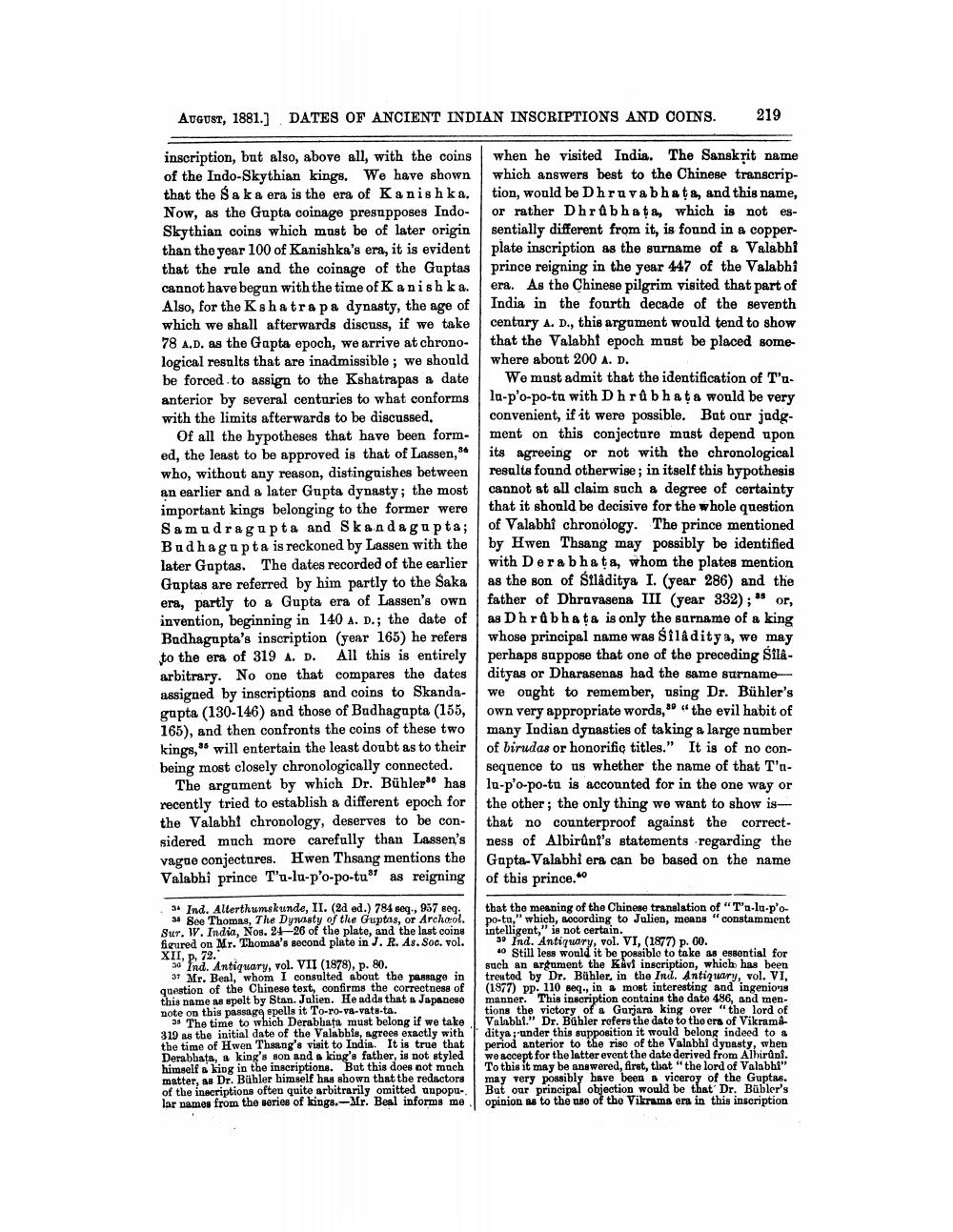________________
AUGUST, 1881.] DATES OF ANCIENT INDIAN INSCRIPTIONS AND COINS. 219
inscription, but also, above all, with the coins of the Indo-Skythian kings. We have shown that the Sa ka era is the era of Kanishka. Now, as the Gupta coinage presupposes IndoSkythian coins which must be of later origin than the year 100 of Kanishka's era, it is evident that the rule and the coinage of the Guptas cannot have begun with the time of Kanishka. Also, for the Kshatra pa dynasty, the age of which we shall afterwards discuss, if we take 78 A.D. as the Gupta epoch, we arrive at chronological results that are inadmissible; we should be forced to assign to the Kshatrapas a date anterior by several centuries to what conforms with the limits afterwards to be discussed.
when he visited India. The Sanskrit name which answers best to the Chinese transcription, would be Dhruvabhata, and this name, or rather Dhrabhata, which is not essentially different from it, is found in a copperplate inscription as the surname of a Valabhi prince reigning in the year 447 of the Valabhi era. As the Chinese pilgrim visited that part of India in the fourth decade of the seventh century A. D., this argument would tend to show. that the Valabhi epoch must be placed somewhere about 200 A. D.
Of all the hypotheses that have been formed, the least to be approved is that of Lassen, who, without any reason, distinguishes between an earlier and a later Gupta dynasty; the most important kings belonging to the former were Samudragupta and Skandagupta; Budhagupta is reckoned by Lassen with the later Guptas. The dates recorded of the earlier Guptas are referred by him partly to the Saka era, partly to a Gupta era of Lassen's own invention, beginning in 140 A. D.; the date of Budhagupta's inscription (year 165) he refers to the era of 319 A. D. All this is entirely arbitrary. No one that compares the dates assigned by inscriptions and coins to Skandagupta (130-146) and those of Budhagupta (155, 165), and then confronts the coins of these two kings, will entertain the least doubt as to their being most closely chronologically connected.
35
The argument by which Dr. Bühler" has recently tried to establish a different epoch for the Valabhi chronology, deserves to be considered much more carefully than Lassen's vague conjectures. Hwen Thsang mentions the Valabhi prince T'a-lu-p'o-po-tu as reigning
3. Ind. Alterthumskunde, II. (2d ed.) 784 seq., 957 seq. 35 See Thomas, The Dynasty of the Guptas, or Archool. Sur. W. India, Nos. 24-26 of the plate, and the last coins figured on Mr. Thomas's second plate in J. R. As. Soc. vol. XII, p. 72.
30 Ind. Antiquary, vol. VII (1878), p. 80.
37 Mr. Beal, whom I consulted about the passage in question of the Chinese text, confirms the correctness of this name as spelt by Stan. Julien. He adds that a Japanese note on this passage spells it To-ro-va-vats-ta.
38 The time to which Derabhata must belong if we take 319 as the initial date of the Valabbis, agrees exactly with the time of Hwen Thsang's visit to India. It is true that Derabhata, a king's son and a king's father, is not styled himself a king in the inscriptions. But this does not much matter, as Dr. Bühler himself has shown that the redactors of the inscriptions often quite arbitrarily omitted unpopu-. lar names from the series of kings.-Mr. Beal informs me
35
We must admit that the identification of T'ula-p'o-po-tu with D hrâ bha ta would be very convenient, if it were possible. But our judgment on this conjecture must depend upon its agreeing or not with the chronological results found otherwise; in itself this hypothesis cannot at all claim such a degree of certainty that it should be decisive for the whole question of Valabhî chronology. The prince mentioned by Hwen Thsang may possibly be identified with Derabhata, whom the plates mention as the son of Silâditya I. (year 286) and the father of Dhruvasena III (year 332); or, as Dhrabhata is only the surname of a king whose principal name was Siladitya, we may perhaps suppose that one of the preceding Śilâdityas or Dharasenas had the same surname we ought to remember, using Dr. Bühler's own very appropriate words, "the evil habit of many Indian dynasties of taking a large number of birudas or honorific titles." It is of no consequence to us whether the name of that T'nlu-p'o-po-tu is accounted for in the one way or the other; the only thing we want to show isthat no counterproof against the correctness of Albirûnî's statements regarding the Gupta-Valabhi era can be based on the name of this prince.*
39
that the meaning of the Chinese translation of "T'u-lu-p'opo-tu," which, according to Julien, means "constamment intelligent," is not certain.
39 Ind. Antiquary, vol. VI, (1877) p. 60.
0 Still less would it be possible to take as essential for such an argument the Kavi inscription, which has been treated by Dr. Bühler. in the Ind. Antiquary, vol. VI, (1877) pp. 110 seq., in a most interesting and ingenions manner. This inscription contains the date 486, and mentions the victory of a Gurjara king over "the lord of Valabhi." Dr. Bühler refers the date to the era of Vikramaditya; under this supposition it would belong indeed to a period anterior to the rise of the Valabhi dynasty, when we accept for the latter event the date derived from Albirûnî. To this it may be answered, first, that "the lord of Valabhi" may very possibly have been a viceroy of the Guptas. But our principal objection would be that Dr. Bübler's opinion as to the use of the Vikrama era in this inscription




